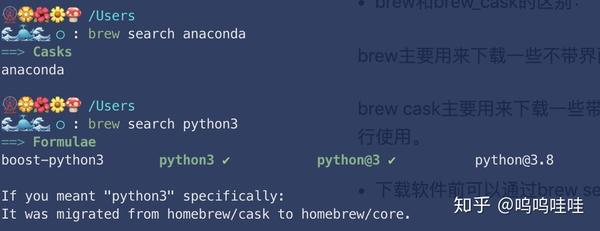- Homebrew Anaconda 3
- How To Install Conda
- Installing Conda Mac
- Homebrew Uninstall Anaconda
- Windows Install Conda
Question or issue on macOS:
Homebrew complements macOS (or your Linux system). Install your RubyGems with gem and their dependencies with brew. “To install, drag this icon” no more. Homebrew Cask installs macOS apps, fonts and plugins and other non-open source software. Anaconda does not ship auto-sklearn, and there are no conda packages for auto-sklearn.Thus, it is easiest to install auto-sklearn as detailed in the Section Installing auto-sklearn.A common installation problem under recent Linux distribution is the incompatibility of the compiler version used to compile the Python binary shipped by AnaConda and the compiler installed by the distribution. Anaconda - The Enterprise Data Science Platform for Data Scientists, IT Professionals and Business Leaders. Homebrew - The Missing Package Manager for macOS. Follow the sequence carefully to easily create the environment and Install softwares and libraries like numpy, scipy, matplotlib, Anaconda distribution of P.
I have just got a new Macbook with OSX Sierra, so want to ensure my development environment is setup properly.
I am looking to follow the ‘best practices’ mentioned here: https://github.com/nicolashery/mac-dev-setup
I need Python 2.x for work (urllib, Pandas, Numpy, Scikit-learn), and Python 3.x for some online classes (Pandas, Numpy, Django) I am taking.
I have installed Python 2 and 3, using brew install python and brew install python3 respectively.
However, on this link, there is no mention of Anaconda, just IPython.
Given that I already have Python 2 and 3 installed via Homebrew, is it even advisable to use anaconda, or should I stick to standard IPython as mentioned on the Github link above?
I am confused after reading this post: OS X – Deciding between anaconda and homebrew Python environments


If Brew and Anaconda can indeed work together, what specific steps can I take to ensure that there are no conflicts between the two versions?

How to solve this problem?
Solution no. 1:
brew and conda tend not to play nicely together, but I think I have a set up that has worked quite well for me so far. It was inspired by this post.
You can add the following code to your .zshrc:
Homebrew Anaconda 3
You want to deactivate conda before running brew so that brew doesn’t find conda packages in your PATH whenever it tries to install something. In fact, brew doctor will complain if you have not deactivated conda before running brew, as mentioned in the post I link to above. (See also this question.)
One thing I should mention is that conda environments “stack”, but the brew() function I’ve written above does not keep track of your stack of environments. (See below for a version of this function that keeps track of this.) For example, if you do conda activate newenv while a conda environment oldenv is active, then conda deactivate will return you to oldenv. However, if you run brew using the function I’ve written above after activating oldenv and then newenv, running conda deactivate will not return you to oldenv but will deactivate your conda environments entirely.
This function also probably creates some unnecessary overhead when running brew, as I believe you only really need to deactivate your conda environment when running brew install. That said, if you’re the kind of person to care about that overhead enough, this answer probably doesn’t tell you anything you didn’t already know.
As a final note, brew cask install anaconda does not strike me as a good idea, since conda was designed to be installed in $HOME, but brew cask will want to install it in /usr/local, so that could lead to unpredictable behaviour.
Edit: Here’s is a version of the brew function which leaves your conda environments as it found it:
I’ve tested this in Zsh. I don’t think it will work in Bash. If you want to use it in Bash, you will need to change the for loop declaration to say something like for env in ${conda_envs[@]}. I haven’t tested this, however, so please test that it does what you need before use.
Solution no. 2:
I am new to python, and have had trouble with my python installation. I have both python installation from homebrew and anaconda on my mac. My anaconda installation had messed up my homebrew python dependency for vim and MacVim.
How To Install Conda
My solution is whenever I am installing/update package via homebrew I would remove anaconda from my PATH. This is a bit of a pain, but I only installing/updating package via homebrew once in a while so it okay.
To switch between python 2 and 3 here are my commands in Terminal:
I found this command from
How to change default Anaconda python environment
and
http://chris35wills.github.io/conda_python_version/

Also, here is a very good article on best practice on setting up python environment on mac
https://www.davidculley.com/installing-python-on-a-mac/
Solution no. 3:
Installing anaconda would mean you have no need of the system Python (leave it to the system, since you probably don't want to change it), or of Pythons installed by homebrew.
Installing Conda Mac
When you create a conda environment you can specify which version of Python you want it to use. For example:
Homebrew Uninstall Anaconda

Activating a conda environment (after the above command you'd do this with conda activate myenv, or source activate myenv for earlier versions) automatically means that the python command will run the Python interpreter you selected for that environment. Packages can be installed with pip as well as conda install, and are pretty much compatible with conda environments.
Windows Install Conda
Solution no. 4:
You can set up a virtual environment (virtualenv) and assign different versions Python to each so there wouldn't be any overlap causing dependency issues.
Check out 'The Hitchhiker's Guide to Python' on how to walk through the setup.
Hope this helps!
